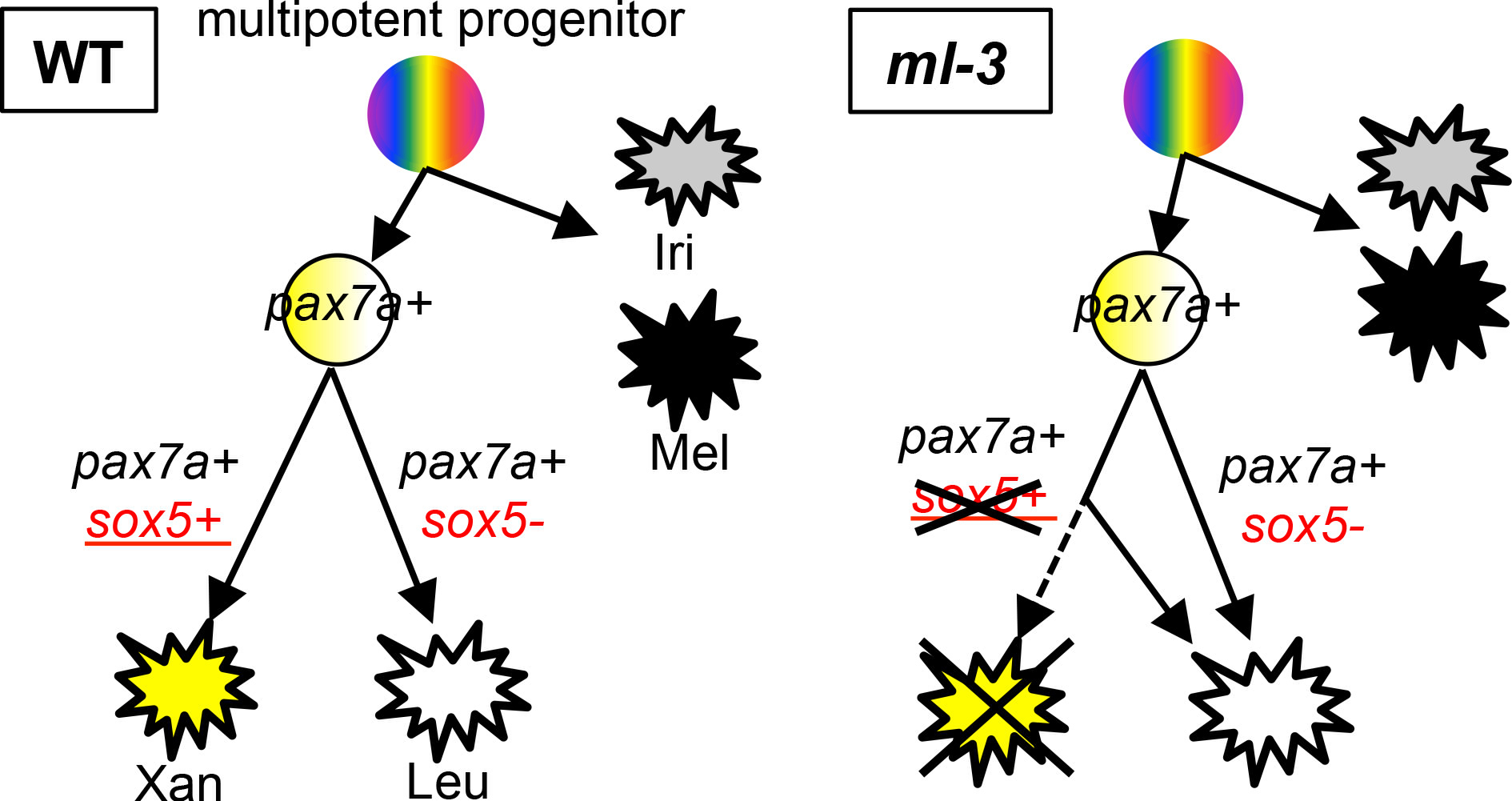Neural crest cells-differentiation of pigment cells
Distinct interactions of Sox5 and Sox10 in fate specification of pigment cells in medaka and zebrafish [Pubmed]
How individual cell fates become specified from multipotent progenitors is a fundamental question in developmental and stem cell biology. Body pigment cells derive from a multipotent progenitor, but while in zebrafish there are three types of pigment cells (melanocytes, iridophores and xanthophores), in medaka these progenitors form four (as zebrafish, plus leucophores). Here, we address whether mechanisms generating each cell-type are conserved between the two species. We focus on two key regulatory proteins, Sox5 and Sox10, which we previously showed were involved in pigment cell development in medaka and zebrafish, respectively. We compare experimentally how the two proteins interact in regulating development of each of the pigment cell lineages in these fish. We show that development of all pigment cells, except leucophores, is dependent on Sox10, and that Sox5 modulates Sox10 activity antagonistically in all pigment cells in zebrafish, and melanocytes and iridophores in medaka. Surprisingly, in medaka, Sox5 acts co-operatively with Sox10 to promote xanthophore fate and to repress leucophore fate. Our findings reveal surprising diversity how Sox5 and Sox10 interact to govern pigment cell development in medaka and zebrafish, and suggest that this likely relates to the evolution of the novel leucophore pigment cell type in medaka.

Functional interactions of Sox5 and Sox10 in pigment cell development in zebrafish and medaka. In zebrafish Sox5 functions to inhibit Sox10 in differentiation of all the pigment cell lineages, melanophores (M), iridophores (I), and xanthophores (X). In medaka, Sox5 counteracts Sox10 in melanophore and iridophore lineages whereas Sox5 cooperates with Sox10 to promote xanthophore specification but to repress leucophores (L) formation.
Sox5 functions as a fate switch in medaka pigment cell development [Pubmed]
How individual cell fates are specified from multipotent progenitor cells is a fundamental question in developmental and stem cell biology. Accumulating evidence indicates that stem cells develop into each of their final, diverse cell-types after progression through one or more partially-restricted intermediates, but the molecular mechanisms underlying final fate choice are largely unknown. Neural crest cells (NCCs) give rise to diverse cell-types including multiple pigment cells and thus are a favored model for understanding the mechanism of fate specification. We have investigated how a specific fate choice is made from partially-restricted pigment cell progenitors in medaka. We show that Sry-related transcription factor Sox5 is required for fate determination between yellow xanthophore and white leucophore, and its loss causes excessive formation of leucophores and absence of xanthophores. We demonstrate that Sox5 functions cell-autonomously in the xanthophore lineage in medaka. Furthermore, pax7a is expressed in the partially-restricted progenitor cells shared with xanthophore and leucophore lineages, and Sox5 acts in some of these cells to promote xanthophore lineage. Our work reveals the role of Sox5 as a molecular switch determining xanthophore versus leucophore fate choice from the shared progenitor, and identifies an important mechanism regulating pigment cell fate choice from NCCs.

Model for xanthophore (Xan) and leucophore (Leu) development from neural crest. xanthophores and leucophores develop from shared progenitors. Sox5 functions to control fate specification of xanthophores in place of leucophores. In the progenitors, pax7a+ sox5+ cells are specified to xanthophore fate whereas pax7a+ sox5- cells give rise to leucophores. In ml-3 mutants, loss of functional Sox5 causes a failure of xanthophore specification, resulting in all progenitors becoming specified to leucophore fate. Differentiation of melanophores (Mel) and iridophores (Iri) does not depend on pax7a or sox5.